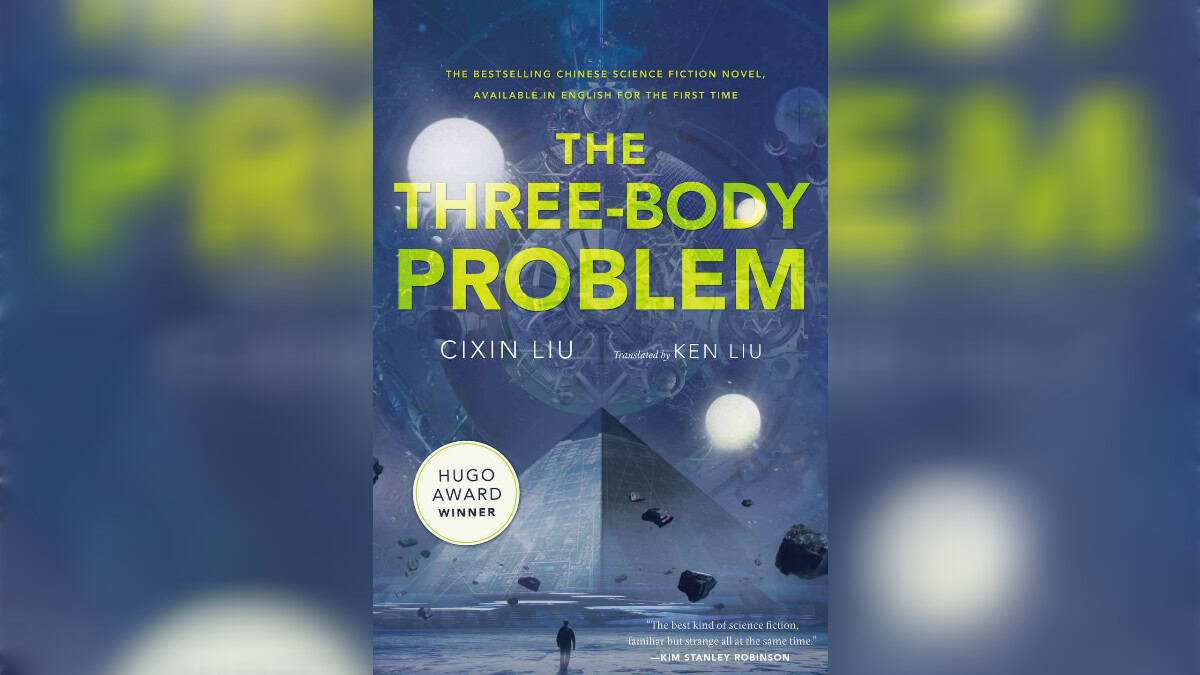Cixin Liu’s The Three-Body Problem is a hard science fiction novel that pushes the boundaries of imagination and human understanding. It is the first book in the Remembrance of Earth’s Past trilogy and introduces readers to a sprawling narrative that combines astrophysics, history, and philosophy. As Liu expertly weaves science and social commentary, this Three-Body Problem review will explore the thought-provoking themes and complex ideas within the book. Winner of the Hugo Award for Best Novel, The Three-Body Problem is widely praised for its intellectually stimulating look at our place in the ever-expanding universe.
Plot Overview: A Collision Between Science and Humanity
The novel begins during the tumultuous Chinese Cultural Revolution, where young astrophysicist Ye Wenjie witnesses her father’s unjust execution at the hands of the Red Guards. Deeply disillusioned by humanity’s cruelty, Ye joins a secret military research project at the newly established Red Coast Base. The ambitious goal of the research unit is to establish contact with intelligent alien civilizations across the vastness of space.
Unbeknownst to her colleagues, Ye’s misguided attempt at first contact with an extraterrestrial race sets in motion a seemingly unstoppable chain of events. She manages to successfully communicate with the Trisolarans, aliens inhabiting a planet with three suns locked in an unpredictable orbital dance. This chaotic gravitational pull results in catastrophic climate shifts and environmental instability on their world. Liu masterfully reveals how Ye’s act of communicating with the desperate Trisolarans introduces humans to an emerging threat, as the aliens secretly prepare to invade Earth to escape the turmoil of their home planet.

The Mysterious World of Three Suns
Liu’s depictions of Trisolaris and its inhabitants are particularly fascinating, lending an air of mystery and intrigue to an alien race driven to survive at all costs. The Trisolarans evolved on a planet with three suns – an astronomical configuration known as the Three-Body Problem in physics due to its chaotic and unpredictable effects. With this backdrop, Liu portrays a civilization shaped by perpetual upheaval, where inhabitants must adapt quickly to radical climate swings or perish.
Through the Trisolarans, the reader gains insight into how completely different forms of life may emerge under dissimilar conditions than those found on Earth. This Three-Body Problem review highlights how Liu uses the Trisolarans and their world as an thought-provoking analogy for humanity’s small place in the grand, unpredictable scheme of the universe.
A Virtual Reality Game: Three Body
One way Liu drives home complex ideas is through an interactive virtual reality game called Three Body, prominently featured in the novel. Players immerse themselves in a simulated world representative of Trisolaris, facing unpredictable climate calamities as inhabitants must quickly adjust to drastic environmental shifts or meet their demise.
The game serves as a metaphor for the unexpected twists scientific discovery can bring, and how advancement sometimes occurs without consideration for consequences. It also parallels humanity’s own fragile position, as small changes to our planet’s conditions could prove just as catastrophic as those on Trisolaris. Through inventive devices like Three Body, Liu’s The Three-Body Problem delivers challenging perspectives that linger with readers long after the final page.
- Exploring Psychological Fiction: Unraveling the Mysteries of the Human Psyche
- Discover Inner Calm: 10 Nonfiction Books to Tackle Stress and Anxiety
- Exploring the Potential Pitfalls of Book Clubs and Literary Snobbery
- Elevate Your Life: The Essential Annual Reading List for Maximum Effectiveness
Themes in The Three-Body Problem
The Intersection of Science and Morality
One of the most prominent themes in Cixin Liu’s The Three-Body Problem is the delicate relationship between scientific progress and moral accountability. Ye Wenjie’s fateful decision to contact the Trisolarans stems from her despairing view of humanity after witnessing her father’s brutal death under the chaotic Cultural Revolution. However, her actions catalyze unintended consequences that imperil Earth’s security. Liu challenges readers to consider how unrestrained scientific ambition could unleash unforeseen harms if not balanced with wisdom and restraint. Ye’s well-intentioned but impulsive move demonstrates how even the most advanced technological achievements cannot promise exclusively good outcomes without principles of ethics to guide their application.
Humanity’s Place in the Cosmos
Liu also examines humanity’s significance in the grand cosmological scale. Through the lurking danger of potential Trisolaran invasion, the characters and readers alike are forced to face Earth’s vulnerability and limitations in comparison to threats beyond comprehension. Even with the progress of civilization, we remain susceptible to disruptions outside direct control. Liu’s perspectives fundamentally reshape conventional assumptions of humanity’s position among the stars, evoking searching queries about survival, changeability and cooperation when up against forces larger than ourselves.
The Trisolarans: Aliens as a Mirror for Human Reflection
The enigmatic Trisolaran race serves as a reflective mirror for considering humanity’s fears surrounding survival under duress. Their homeworld’s volatile environmental constraints drove the evolution of an unemotional, rational societal structure purely aimed at perseverance through any crisis. This contrasts markedly with humanity’s tendency towards irrationality and emotion. Liu invites contemplation of whether we possess the foresight and versatility to change rapidly enough when facing complex new uncertainties.
His imaginings of an alien species adapted to dissimilar conditions prompts self-examination of our current readiness and capacity for both principled complexity and radical transformation in response to unforeseen scenarios. The Trisolarans represent an intriguing antithesis that highlights strengths and weaknesses latent within human nature worthy of reflection.
Character Analysis: Scientific Minds in a Chaotic World
Ye Wenjie: A Morally Ambiguous Heroine
Ye Wenjie is one of Cixin Liu’s most richly developed characters, driven simultaneously by personal grief and intellectual curiosity. Her historic choice to betray humanity stems from disillusionment after witnessing her father’s senseless death amidst the Cultural Revolution’s chaos. Though her actions imperil Earth’s future, Liu ensures readers appreciate Ye as tragically heroic – fighting against resignation through connection with another civilization. Her moral ambiguity mirrors the novel’s broader inquiry into science’s capacity for progress or destruction. In Ye, Liu poses profound questions about whether any ends could vindicate such costly means of discovery.
Wang Miao: The Reluctant Protagonist’s Journey
Nanomaterials researcher Wang Miao begins as the novel’s reluctant protagonist, skeptical of vague connections between scientific fields. His investigative journey reveals hidden truths about the Trisolaran threat and reshapes his understanding of humanity’s place in the cosmos. Through Wang, Liu explores the tension scientists face balancing detached analysis with emotional stakes in their work. His evolution mirrors humanity’s struggle to reconcile intellectual growth with responsibility over consequences. Wang provides a lens inviting readers on a reflective journey alongside him.
The Trisolarans: Survival’s Impact on Rationality
Despite differences, the Trisolarans’ struggle for survival renders them deeply human. Their logical approach to problem-solving, including conquering Earth, represents rationality’s extreme when necessity predominates over compassion. Liu implies neither species has a monopoly on virtue, using the Trisolarans to critique how self-interest and short-term thinking can compromise ethical standards, even for advanced civilizations. Their motivations prompt consideration of survival’s impact on rational processes and empathy across intelligent life.
- Exploring Psychological Fiction: Unraveling the Mysteries of the Human Psyche
- Discover Inner Calm: 10 Nonfiction Books to Tackle Stress and Anxiety
- Exploring the Potential Pitfalls of Book Clubs and Literary Snobbery
- Elevate Your Life: The Essential Annual Reading List for Maximum Effectiveness
Liu’s Visionary Science Fiction: A Blend of Realism and Imagination
Hard Science Fiction at Its Finest
Liu’s background as an engineer is evident in his meticulous incorporation of genuine scientific concepts. From explorations in quantum mechanics to the complexities of astrophysics, The Three-Body Problem immerses readers in painstakingly researched ideas. Liu balances sophisticated theories with gripping storytelling, ensuring each enriches the other. This facilitates a uniquely intellectually stimulating yet emotionally powerful experience. His hybrid approach exemplifies hard sci-fi at its best.
A Global Perspective Renewing the Genre
Distinct from many Western examples, Liu’s narrative derives from a vividly depicted Chinese cultural and historical setting. His integration of the traumatic Cultural Revolution period illuminates Ye Wenjie’s disillusionment and pivotal choices. Beyond entertaining, Liu’s socio-political lens broadens discussion of science fiction’s perennial inquiries. By transplanting speculative elements to a non-Western society, familiar tropes bloom in novel forms. Liu reinvigorates a beloved genre with timely global perspectives, representing all humanity while retaining Chinese artistic roots. His work stands as a shining example of science fiction’s potential for borderless social commentary through imaginative fiction.
Criticism and Reception
Complexity and Accessibility
While praised for its depth of vision, some make note that Cixin Liu’s layered narrative presents challenges for readers less versed in detailed scientific concepts. Liu does not shy away from meticulously researching physics and astronomical notions. However, as with any work pushing boundaries, accessibility requires effort from both author and audience. For engaged readers willing to wrestle with intricate ideas, rewards abound in this introspective journey. Liu invites expanding perspectives through intellectual rigor, exemplifying science fiction at its finest.
Cultural Nuances and the Art of Translation
Liu derives power from anchoring speculative elements in Chinese history and culture. However, certain nuanced threads may lack full clarity in translation to Western audiences. Kenneth Liu faced the virtuoso task of preserving this epic’s complex tone and multilayered commentary while bridging gaps. Additional cultural context could aid appreciation, though differences open inviting avenues for global discussion. Liu transcends borders by exploring timeless questions through regional roots, demonstrating how disciplined creativity may advance shared human understanding across linguistic divides. Both works exhibit the translator’s art and celebrate our commonality.
Strengths and Challenges of The Three-Body Problem
Pros
Ambitious Scope: Liu Cixin’s novel tackles enormous themes—alien civilizations, the nature of the universe, and humanity’s future—on a grand, philosophical scale. By exploring a first contact scenario and its ensuing consequences across centuries, the story manages to contemplate humanity’s place in the cosmos while maintaining scientific rigor.
Complex Characters: The novel’s characters, particularly Ye Wenjie, are deeply flawed and richly drawn, adding emotional depth to the scientific narrative. Characters like Ye Wenjie, whose experiences of the Cultural Revolution shape her later actions, feel hauntingly real and bring analytical dimensions to the thought experiments presented.
Hard Science Fiction: For fans of hard sci-fi, the novel’s rigorous attention to scientific detail and theory makes for a deeply immersive reading experience. Concepts from physics, astronomy, and other STEM fields are woven organically into the story without compromising readability.
Cons
Dense Scientific Exposition: Readers who are not familiar with physics or who prefer more action-driven narratives may find the novel’s heavy focus on scientific exposition challenging. However, the exposition proves crucial to developing the operas logical premise and ominous visions of humanity’s future.
Slow Pacing in Early Chapters: The novel takes its time to build up momentum, especially in the early chapters where political history and scientific background are established. This meticulous setup allows for rich world-building and foreshadowing of conflicts to come.
Conclusion
The Three-Body Problem is a tour de force of hard science fiction, blending complex scientific theories with deep philosophical and political questions about humanity’s place in the universe. Liu Cixin’s epic novel challenges readers to think critically about the consequences of first contact with alien civilizations, the ethics of scientific progress, and the potential dangers of unchecked technological advancement. His thought experiments contain timely warnings as humanity inches closer to discoveries that could reshape civilization. For fans of science fiction that pushes the boundaries of imagination while remaining rooted in real-world science, The Three-Body Problem is a must-read.
If you’re ready to embark on a mind-bending journey through space, time, and human nature, The Three-Body Problem is the novel for you. Pick up your copy today to begin Liu Cixin’s masterful exploration of alien civilizations and existential questions. Readers who stick with it will be rewarded with an epic yet intimate tale. What did you think of the novel’s scientific depth and philosophical themes? Let us know in the comments!





























Add comment